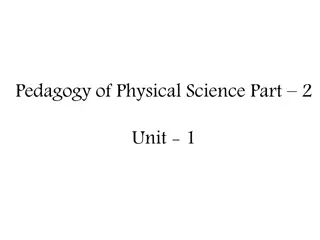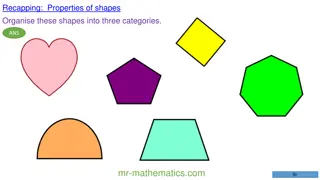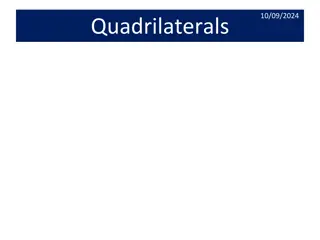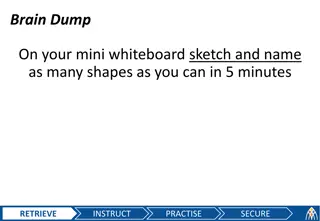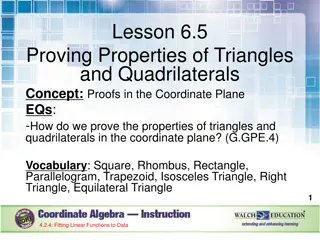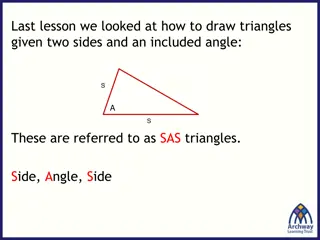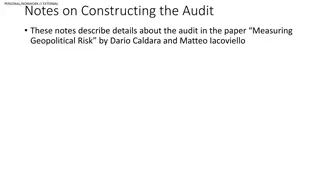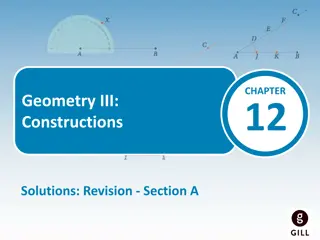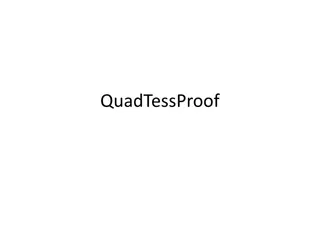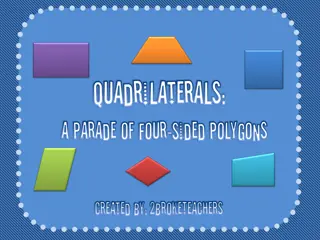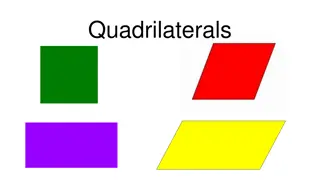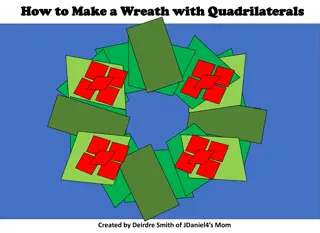Constructing Unique Quadrilaterals using Given Parameters
Learn how to construct a quadrilateral when given specific parameters like sides, diagonals, angles, and special properties. Follow step-by-step instructions to create unique quadrilaterals such as PQRS or ABCD using geometric criteria and arc constructions.
Download Presentation

Please find below an Image/Link to download the presentation.
The content on the website is provided AS IS for your information and personal use only. It may not be sold, licensed, or shared on other websites without obtaining consent from the author.If you encounter any issues during the download, it is possible that the publisher has removed the file from their server.
You are allowed to download the files provided on this website for personal or commercial use, subject to the condition that they are used lawfully. All files are the property of their respective owners.
The content on the website is provided AS IS for your information and personal use only. It may not be sold, licensed, or shared on other websites without obtaining consent from the author.
E N D
Presentation Transcript
CONSTRUCTING A QUADRILATERAL
WE SHALL LEARN HOW TO CONSTRUCT A UNIQUE QUADRILATERAL BY FOLLOWING METHODS :- When four sides and one diagonal are given. When two diagonals and three sides are given. When two adjacent sides and three angles are given. When three sides and two included angles are given. When other special properties are known.
CONSTRUCTING A QUADRILATERAL CONSTRUCTING A QUADRILATERAL WHEN FOUR SIDES AND ONE WHEN FOUR SIDES AND ONE DIAGONAL ARE GIVEN DIAGONAL ARE GIVEN Example : Construct a quadrilateral PQRS where PQ = 4cm, QR = 6cm, RS= 5cm, PS = 5.5cm and PR = 7cm 7 cm ROUGH SKETCH
Step 1 :- Construct a triangle PQR using SSS criterion. 7 cm
STEP 2 :- WITH P AS CENTRE DRAW AN ARC OF RADIUS 5.5 CM . 7 cm
STEP 3 :- NOW, WITH R AS CENTRE DRAW AN ARC OF RADIUS 5 CM INTERSECTING ANOTHER ARC AT POINT S 7 cm
STEP 4 :- NOW JOIN PS AND RS. 7 cm PQRS is the required quadrilateral.
CONSTRUCTING A CONSTRUCTING A QUADRILATERAL WHEN TWO QUADRILATERAL WHEN TWO DIAGONALS AND THREE SIDES DIAGONALS AND THREE SIDES ARE GIVEN. ARE GIVEN. Example : Construct a quadrilateral ABCD, given that BC =4.5 cm, AD = 5.5 cm, CD = 5 cm, AC = 5.5 cm and diagonal BD = 7 cm. C 7 cm B D 5.5cm A ROUGH SKETCH
STEP 1 :- DRAW TRIANGLE ACD USING SSS CRITERION D A C 5.5 cm
STEP 2 :- WITH D AS CENTRE DRAW AN ARC OF RADIUS 7 CM. D A C 5.5 cm
STEP 3 :- NOW, WITH C AS CENTRE DRAW AN ARC OF RADIUS 4.5 CM INTERSECTING ANOTHER ARC AT POINT B. D A C 5.5 cm B
STEP 4 :- JOIN AB, DB AND CB D 7 cm ABCD is required triangle A C 5.5 cm B
CONSTRUCTING A QUADRILATERAL WHEN TWO ADJACENT SIDES AND THREE ANGLES ARE KNOWN a Construct : Example M quadrilate MIST ral where 120 = = 105 MI 3.5 cm, IS 6.5 cm, T I = 120 = M 75 , I and 105 = S 75 ROUGH SKETCH S
Step - : 1 3.5 = Draw a line MI cm MIX 105 = and make an . X 105 I M 3.5 cm
Step - : 2 = Measure IX 5 . 6 and name that point S. Now make Y ISY 120 = . X 120 S 105 I M 3.5 cm
Step - : 3 = Now make IMZ 75 Z Y X S 120 75 105 I M 3.5 cm
STEP 4 :- MARK THAT POINT T WHERE SY AND MZ MEET. Y Z T X S 120 MIST is the required Quadrilateral. 105 75 I M 3.5 cm
CONSTRUCTING A QUADRILATERAL WHEN THREE SIDES AND TWO INCLUDED DIAGONALS ARE GIVEN. Construct - : Example a D C Quadrilate = ABCD, ral where 5 = AB 4 = cm, Bc cm, = CD 6.5 cm, B 105 80 = B and C . A 4 cm ROUGH SKETCH
Step - : 1 5 = Draw a line BC cm and Draw an of 105 along BX. X 105 C B 5 cm
Step - : 2 4 = Measure BX cm and name that point A. X A 105 C B 5 cm
Step - : 3 = Now make BCY 80 Y X 105 80 C B 5 cm
Step - : 4 centre, as C with Now, Draw an arc of length 6.5 cm point at CY cuts that D. Y D X 105 80 C B 5 cm
Step5 - : Join AD Y X D ABCD is the required Quadrilateral. 105 80 C B 5 cm
CONSTRUCTING A QUADRILATERAL WHEN OTHER SPECIAL PROPERTIES ARE KNOWN. Some examples are :- Draw a square of side 5 cm. Construct a rhombus ABCD where AC = 6 cm, and BD = 7 cm. 1. 2.
EXAMPLE 1 :- DRAW AN SQUARE ABCD OF SIDE 5 CM. only one measurements only one measurements has been given. Actually has been given. Actually we have many more we have many more details with us, because details with us, because the figure is special the figure is special quadrilateral namely a quadrilateral namely a square. We know that square. We know that each of its angles is a each of its angles is a Right angle. Right angle. Initially it appears that Initially it appears that 4.5 cm C D 90 90 4.5 cm 4.5 cm 90 90 B A 4.5 cm
EXAMPLE 2 :- CONSTRUCT A RHOMBUS ABCD WHERE AC = 6 CM, AND BD = 7 CM. As we know the diagonals of Rhombus are Perpendicular bisectors of one another. So, first we draw AC = 7 cm and construct its perpendicular bisector. Let them meet at O. cut off 3 cm lengths on either side of the drawn bisector . You get now B and D. D 6 cm A O C 7 cm B


